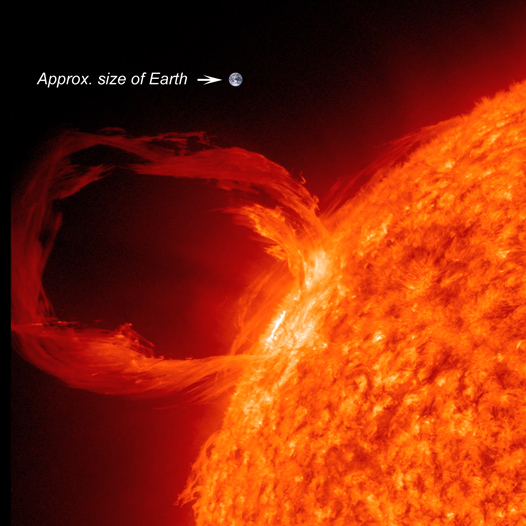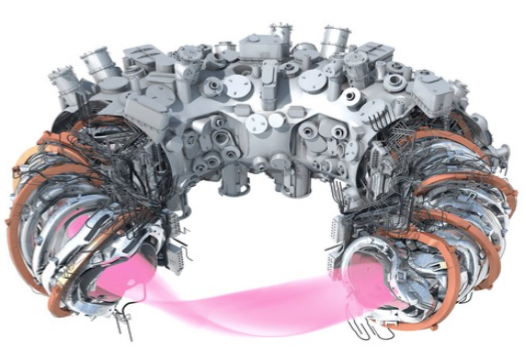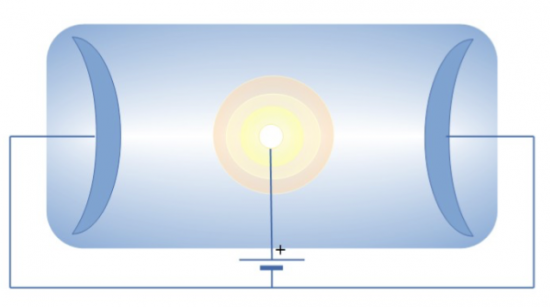
Solar Energy is Our Future
by Mathias Hüfner
Climate change is forcing our society to switch from fossil fuels to climate neutral fuels. Wind energy and photovoltaic will not be enough to satisfy the growing hunger for energy of an ever larger world population. As a result, nuclear energy comes back into focus. During the nuclear fission of uranium, however, highly radioactive fission products occur that emit biologically harmful alpha radiation over thousands of years. The safe storage of this waste for such long periods of time is an unsolved problem. That is why the generation of energy from nuclear fusion (transmutation) is an alternative, since no alpha radiation occurs with light atomic nuclei and the electron radiation decays very quickly.
Classic fusion experiments
Based on the classic solar model, which assumes that the sun is a fiery gas ball, inside which hydrogen fuses to helium and the heat is transported to the surface by neutrinos, Andrei Sakharov started his first attempts at the Moscow Kurchatov Institute in 1952 for technical nuclear fusion. Its principle was the inclusion of a plasma ring in a magnetic field, which should be heated up in the magnetic field enough to start the nuclear fusion. The idea was that after the ignition, the fusion would continue by itself, as had been observed with nuclear fission. Therefore, the experiments were designed for pulse operation. This principle was named ‚Tokamak‘. It is short for „тороидальная камера в магнитных катушках“ (toroidalnaja kamera w magnitnych katuschkach) translates Thoroidal Chamber Into Magnetic Coils.
However, there were two problems with this principle. The first was that the Lorentz force swirled the plasma and the chamber walls cooled the plasma. The swirling was finally countered with a complicated magnetic field design that was modeled on a multi-twisted Möbius tape. This created a helical magnetic field. This principle was called the Stellarator, meant a machine which works like a star. However, more than 60 fruitless years had to pass before the new principle was decided.
On December 10, 2015, a short flash of light in the form of a helium plasma was finally generated for the first time on the Tokamak Stellarator Wendelstein 7-X fusion generator in Greifswald, Germany. To carry out this experiment, it took 9 years of construction, in which several hundred tons of material were used. The project devoured over a billion euros.
On June 25, 2018, the Max Planck Institute for Plasma Physics issued a press release: Stellarator record in fusion product: „Jetzt hat Wendelstein 7-X einen Rekord aufgestellt. Denn es erreichte nie zuvor gemessene Höchstwerte für das sogenannte Fusionsprodukt. Dieses Produkt aus Ionentemperatur, Plasmadichte und Energieeinschlusszeit gibt an, wie nahe man den Reaktorwerten für ein brennendes Plasma kommt. In den Testdurchgängen des Jahres 2017 wurde das Plasma im Reaktor auf rund 40 Millionen Grad Ionentemperatur aufgeheizt und hatte eine Dichte von 0,8 x 1020 Teilchen pro Kubikmeter.“ Up to 75 megajoules of heating energy were used for the heating and the plasma survived 2 seconds. However, there was still no sign of fusion. Wendelstein 7-X is currently out of service and is being renovated.

A great technical achievement, as you would think, only our sun is a G2 star and there are only 5600 degrees on the surface and there are no traces of helium in its atmosphere. But inside hydrogen is said to burn at 15 million degrees to helium. If that were true, the sun would be a giant hydrogen bomb that should have exploded.
Not much can be known about the interior of the sun. The core may be made of liquid calcium. The density of the sun and the spectral class support this assumption. What forces should hold this bomb together? Ironically, the weakest of the four classic forces, gravitation? You can doubt it. The temperatures necessary for nuclear reactions can be found in the solar corona.
Theoretical considerations
According to Boltzmann, the kinetic energy of the atoms is a function of the temperature. From this, the mean velocity of a proton in the plasma can be estimated at a corresponding temperature. According to Boltzmann, this results in a speed in one direction of v = √ (kT / 2m) and at 40 million degrees, as the Stellarator has reached, that is around 400km/s. This is about the speed at which the solar wind enters the earth’s atmosphere. The protons should collide at this speed to fuse. However, this will not happen if they race parallel through the thorax of the Stellarator. The Stellarator principle is based on a closed system. According to the 2nd law of thermodynamics, entropy will only grow in it. However, this means that no structures can form. A nuclear fusion is therefore impossible. But in reality the Stellarator is not a closed system, energy is constantly being supplied to it, but in order to reach a high temperature, scientists are concerned that no energy can flow away. The ingenious Prigogine teaches, however, that in an open system the entropy of the system is the sum of the external and internal entropy and the external entropy is made up of the difference between the introduced and the removed entropy of the open system. Now you can see that the external entropy at the Stellarator is larger than the internal one. In order to build up a structure and to start transmutation, entropy must be extracted in the form of electrons, but this is not intended for the Stellarator.
Einstein, in his delusion, having to symmetrize Maxwell’s equations, banished electrodynamics from the cosmos with the Lorentz transformation, because he did not want to admit that this transformation is a projective transformation, that is, a mapping. He thus strengthened the position of Christianity and Newtonian mechanics and only relied on the gravitational forces, which Immanuel Velikovsky criticized, in discussions with Einstein in the last months of his life.1
Ralph E. Juergens developed an electric sun model as early as 1979.2 Already in 1972 he wrote: “It is interesting to note that the calculated energy density of cosmic rays in our galaxy is comparable to the total energy density of electromagnetic radiation, including starlight.” 3 He recognized the granules on the surface of the sun as anode tufts and an indication of a self-organizing open system. This model was significantly developed by Don Scott. His book “The Electric Sky” 4 was published in 2006.
Don Scott dealt with the questions of why there are two types of solar wind, which electrical process can bring the solar wind to a standstill over two days and what accelerates the solar wind towards Earth. Can sunspots be integrated into the model? Scott believes that the fast solar wind comes from the photospherical clusters and the slow wind comes from the sun spots around the equator. With his transistor model of the sun, he can explain the different speeds and densities of slow and fast solar wind. The solar wind has an average proton density of about 6 particles per cm3 with a fluctuation range of 3 particles per cm3 in a calm sun, as can be seen from http://spaceweather.com. However, the electric sun model had the disadvantage compared to the classic sun model. It could explain a large part of the phenomena observed on the sun, but it could not explain nuclear fusion.
Don Scott was able to identify the butterfly nebula as a Birkeland current constricted by the pinch effect. If you compare the Wendelstein experiment with the butterfly nebula, which represents a star birth, you immediately notice that the construction of the butterfly nebula is much simpler than a Stellarator. In the visible part of the Birkeland current of this nebula, especially in the Z-pinch node, there is a solid body that opposes the hydrogen gas and the protons. This resistance causes a large change in speed in the current. It’s like when a traffic jam suddenly occurs on the highway. Protons have no brakes, so collisions are inevitable. A mass collapse occurs. The entrained hydrogen molecules crash into each other and ions of higher atomic weight are created indiscriminately, unlike at the LHC in Geneva, where the protons are pulverized due to the maximum energy. While the ions are held up by the solid, the electrons penetrate into the body and out of the side almost unchecked.
At this point we have to come back to Maxwell’s equations because they represent the way forward for modern physics. We find two vortices described there, one magnetic and one electric. Nothing is said about their size. As an open system considered div E describes the entrance. The entropy removed is the electromagnetic radiation, which is not explicitly stated. The magnetic vortex is technically represented by a ferrite ring. We used to use such rings as ferrite core memories in computers for one bit. In its technical form, the electrical vortex is usually a copper coil. We call the combination of a ferrite core and two copper coils a transformer.
The ingenious inventor Nicola Tesla first generated radio waves with such a transformer in 1890 by sending an alternating current through the coil. Nicola Tesla has almost completely disappeared from our consciousness, although he has achieved a much greater achievement for humanity than Albert Einstein. He was the one who laid the foundations of AC technology and thus the basis for our modern energy industry.
To generate light waves, one can assume that similar structures to the Tesla transformer are necessary, but they are much smaller due to the much shorter wavelength. Atoms should work similarly to small Tesla transformers if the theory of quantum mechanics did not block our view of them.
Quantum mechanics is essentially a theory of probability. Probability statements are incomplete statements from which no causal conclusions can be drawn, which is why Einstein rejected them. However, atoms are very concrete objects whose quantitative and qualitative properties are clearly delineated. I consider quantum mechanics to be completely unsuitable as an explanatory model for a single atom. On the contrary, it is a rape of physics. It is different when you look at the mass of the electrons. There is no longer a clear delimitation of individual electrons. Only probability statements do help here.
The entire particle zoo is super unstable
The experiments at the LHC brought an important result, which was not appreciated at all. Namely: The whole so-called particle zoo is super unstable. It is also alleged that so-called quarks exist in the atomic nucleus, although they have never been observed. The neutron is said to consist of one up and two down quarks, with the proton it is exactly the opposite. However, this could never be demonstrated experimentally. These theories have no connection to Maxwell’s equations, although the machine with which the investigations were carried out is the largest human-made machine ever that operates on the basis of Maxwell’s equations. It showed that if you shoot two atoms at almost the speed of light, the result is just junk. Fortunately, nature repairs the damage immediately. It has also shown that all matter consists of only two stable components, the proton and the electron and they are only important for the structure of matter.
Paul Marmet5 was able to show that the so-called relativistic increase in mass is due to the magnetic field. Kohlrausch and Weber established the indirect connection between the speed of light and the root of the electromagnetic properties of matter (mass and force) as early as the middle of the 19th century. However, by definition, mass is an uncountable amount of particles. As a result, mass cannot grow, but the optics say that the speed of light changes with the electromagnetic properties of matter, causing the light rays to bend. This makes the general theory of relativity superfluous. The formula of the ‘relativistic mass increase’ remains, only the conclusion is: the proton is a magnetic vortex and the electron is an electric vortex.
So the atom can be understood as consisting of an electrical vortex of the atomic shell and a magnetic core with another current loop inside the core. If the current strength in the shell increases, which is done by reducing the diameter of the current loop, this leads to the emission of entropy in the form of electromagnetic radiation, just as with the Tesla transformer. With this model, we can now build larger units. In Figure 2, the neutron model consists of a proton – a red doughnut – and an electron, a blue doughnut. The neutron is unstable. Its half-life is about 15 minutes. If we now assemble two red doughnuts with a blue one, we get the model for a deuterium nucleus. The result is a permanent magnet. This constellation is stable. But three red doughnuts can also be connected with a blue ring. Here we have the model of a tritium nucleus or a helium nucleus. The difference only becomes visible after the configuration of the electron shell. If only one electron orbits this nucleus, it is an isotope of hydrogen; if it orbits two electrons, we call it the helium nucleus. This core is also unstable, but its half-life is at least 12 years. However, stable helium nuclei (α-particles) consist of two deuterium nuclei that hold together like two permanent magnets. Now we can assemble all chemical elements with these building blocks. I explained in my book6 how this happens in detail.

If we now consider the charge quotient between protons and electrons in the stable atom, we find that it is close to 2. As the mass of the elements increases, it becomes slightly smaller without changing the stability of the atomic nucleus. Now, however, a core must first be built up, and the available electrons are consumed in the core build-up before the shell can be built up at significantly lower temperatures. As a result, the surroundings of the sun will have a positive charge. According to what Ilya Prigogine teaches us, the inner entropy must be removed so that order can arise. This requires a circuit and cooling. If our considerations are correct, we can emulate the butterfly nebula as an electronic circuit.
This principle is been called of Montgomery Childs and a team of five other scientists in 2015 Stellar Atmospheric Function In Regulation Experiment‘ (short SAFIRE7) and was first introduced to the community of the Electric Universe at the EU 2015 conference in Phoenix8, to test the electric solar model. The basic idea of an electric sun is that it is a positively charged body in a negatively charged environment and that nuclear fusion does not take place inside but in its heliosphere. This idea seems so absurd to complacent academic science that the mainstream of scientists has never seriously considered it. These experiments were only possible with the generous support of a private donor, and the budget was therefore not comparable to the funds used for a Stellerator.

The experiment chamber
The experiments are carried out in a large vacuum chamber, which was also called the “star in the glass”. The large number of data generated by the chamber in recent years enables a comparison with the data retrieved by the Sun through the Parker Solar Probe, which is more than just a visual comparison.
An electrical discharge can be generated in the vacuum chamber, which is not too dissimilar to that of a Tesla lamp. The chamber has a volume of about 3 cubic meters and it contains an electrode, usually a spherical positively charged anode, which is surrounded by two large cathodes on the right and left. The gas mixture of hydrogen and nitrogen, the pressure, the voltage and the current (direct current) served as variables. This allowed to study different types of plasma discharges. The resulting properties were measured with a variety of measuring devices. An electrical discharge can be generated in the vacuum chamber, which is not too dissimilar to that of a Tesla lamp. The gas mixture of hydrogen and nitrogen, the pressure, the voltage and the current (direct current) served as variables. This allowed to study different types of plasma discharges. The resulting properties were measured with a variety of measuring devices.

Results
The experiment was carried out in three phases. The basic functionality of the experiment was tested in the first phase before a correspondingly large vacuum chamber with extensive measuring equipment was set up in the second phase.
The plasma stability was found out with the Design of experiments. The anode glow light shows different appearances depending on the gas mixture, current strength, voltage and pressure. Tufts appeared first on the anode, later double layers and finally a very hot plasma at a temperature of over 81,000 K before it discharged into an arc. The mass numbers 1, 2, 3 and 18 occurred in the gas analysis. While the mass number 1 was 1%, the mass number 2 was 65% and the mass numbers 3 and 18 were 17%. Since the gas filling was a hydrogen-nitrogen mixture, the mass numbers 1 and 18 are explained. The numbers 2 and 3 in the high concentration remained puzzling for the research team. This indicates the presence of deuterium and tritium building blocks, which was not expected. Effective temperatures very close to the anode of 81,000 K were measured.
Before the third phase began, I had the opportunity at the EU2017 as a volunteer and the only German participant at this conference to speak personally with Monty Childs about his third phase and also with Edwin Kaal about his structured atomic model.9
The third phase, after mastering the plasma, started to study nuclear fusion. After 5 years of research into the plasma regime, an effect occurred that was not expected. One day 100% of the planned heating energy was achieved with only 7% of the input energy. The double layers disappeared and the whole anode glowed in the bright light of a little sun.10 When the deposits on the changed anode were examined, traces of a number of elements such as carbon, sodium, magnesium, aluminum, silicon, but also calcium and some heavy elements such as barium, lanthanum and cerium were found, that were definitely not in the vacuum chamber before. It was precisely those elements that had long been discovered in the Fraunhofer lines of the solar spectrum that were considered not to come from the sun.
The experiment shows that physics has to be rewritten and that completely new approaches have to be found to understand nuclear fusion. But it also shows that nuclear fusion processors can be operated with relatively modest costs. Such systems would be a very good multiplier for a CO2-free energy economy that relies on batteries, hydrogen and wind energy.
NOTES
1 Mathias Hüfner – “Wer war Velikovsky?“
2 Ralph E. Juergens – The Photosphere: Is It the Top or the Bottom of the Phenomenon We Call the Sun?
3 R. E. Juergens, “Plasma in Interplanetary Space: Reconciling Celestial Mechanics and Velikovskian Catastrophism,” Penseé IVR II (Fall 1972), pp. 6-12; Velikovsky Reconsidered (N. Y., 1976), pp. 137-155. First presented at the Lewis & Clark Symposium, Portland, OR, August 15-17, 1972.
4 Don Scott – “The Electric Sky“
5 Paul Marmet – “Fundamental Nature of Relativistic Mass and Magnetic Fields”
6 Mathias Hüfner – “Modern Astrophysics Meets Engineering: The Reformation of Physics”
7 Montgomery Childs – SAFIRE-Update 2015
8 Montgomery Childs – SAFIRE-Update 2015
9 Edwin Kaal – The Structured Atom Model and Transmutations
10 Montgomery Childs – SAFIRE PROJECT 2019 UPDATE

Mathias Hüfner is a German volunteer of The Thunderbolts Project. He studied physics from 1964 until 1970 in Leipzig Germany, specializing in analytical measurement technology for radioactive isotopes. He then worked at Carl Zeiss Jena until 1978 on the development of laser microscope spectral analysis. There he was responsible for software development for the evaluation of the spectral data. Later he did his doctorate at the Friedrich Schiller University in the field of engineering and worked there 15 years as a scientific assistant. Some years after the change in East Germany he worked as a freelance computer science teacher the last few years before his retirement. Since 2015, he runs a German website of the Thunderbolts project http://mugglebibliothek.de/EU and has published a book entitled “Modern Astrophysics Meets Engineering: The Reformation of Physics”.
The ideas expressed in Thunderblogs do not necessarily express the views of T-Bolts Group Inc. or The Thunderbolts Project.












